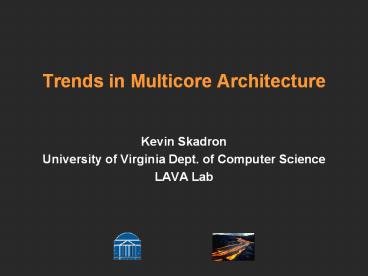Kevin Skadron - PowerPoint PPT Presentation
Title:
Kevin Skadron
Description:
ILP wall: wider superscalar, more aggressive OO execution, have run out of steam ... Niagara. Larrabee. Network processors. Clearspeed. Cell BE. Many others... – PowerPoint PPT presentation
Number of Views:37
Avg rating:3.0/5.0
Title: Kevin Skadron
1
Trends in Multicore Architecture
- Kevin Skadron
- University of Virginia Dept. of Computer Science
- LAVA Lab
2
Outline
- Objective of this segment explain why this
tutorial is relevant to researchers in systems
design - Why multicore?
- Why GPUs?
- Why CUDA?
3
Why Multicore?
- Why the dramatic paradigm shift? Combination of
both ILP wall and power wall - Not just power
- ILP wall wider superscalar, more aggressive OO
execution, have run out of steam - Power wall only way to boost single-thread
performance was to crank frequency - Aggressive circuits (expensive)
- Very deep pipeline 30 stages? (expensive)
- Power-saving techniques werent able to
compensate - This leaves only natural frequency growth due to
technology scaling (20-30 per generation) - Dont need expensive microarchitectures to obtain
that scaling
4
Actual Power
Core 2 Duo
Source Intel
5
The Multi-core Revolution
- Cant make a single core faster
- Moores Law ? same core is 2X smaller per
generation - Need to keep adding value to maintain average
selling price - More and more cache doesnt cut it
- Use all those transistors to put multiple
processors (cores) on a chip - 2X cores per generation
- Cores can potentially be optimized for power
- But harder to program, except for independent
tasks - How many independent tasks are there to run at
once?
6
Single-core Watts/Spec
(through 2005)
(courtesy Mark Horowitz)
7
Where Do GPUs Fit In?
- Big-picture goal for processor designers improve
user benefit with Moores Law - Solve bigger problems
- Improve user experience ? induce them to buy new
systems - Need scalable, programmable multicore
- Scalable doubling processing elements (PEs)
doubles performance - Multicore achieves this, if your program has
scalable parallelism - Programmable easy to realize performance
potential - GPUs can do this!
- GPUs provide a pool of cores with general-purpose
instruction sets - Graphics has lots of parallelism that scales to
large cores - CUDA leverages this background
- Need to maximize performance/mm2
- Need high volume to achieve commodity pricing
- GPUs of course leverage the 3D market
8
How do GPUs differ from CPUs?
- Key perf/mm2
- Emphasize throughput, not per-thread latency
- Maximize number of PEs and utilization
- Amortize hardware in timemultithreading
- Hide latency with computation, not caching
- Spend area on PEs instead
- Hide latencies with fast thread switch and many
threads/PE - GPUs much more aggressive than todays CPUs 24
active threads/PE on G80 - Exploit SIMD efficiency
- Amortize hardware in spaceshare fetch/control
among multiple PEs - 8 in the case of Tesla architecture
- Note that SIMD?? vector
- NVIDIAs architecture is scalar SIMD (SIMT),
AMD does both - High bandwidth to global memory
- Minimize amount of multithreading needed
- G80 memory interface is 384-bit, R600 is 512-bit
- Net result 470 GFLOP/s and 80 GB/s sustained in
G80 - CPUs seem to be following similar trends
9
How do GPUs differ from CPUs? (2)
- Hardware thread creation and management
- New thread for each vertex/pixel
- CPU kernel or user-level software involvement
- Virtualized cores
- Program is agnostic about physical number of
cores - True for both 3D and general-purpose
- CPU number of threads generally f( cores)
- Hardware barriers
- These characteristics simplify problem
decomposition, scalability, and portability - Nothing prevents non-graphics hardware from
adopting these features
10
How do GPUs differ from CPUs? (3)
- Specialized graphics hardware(Here I only talk
about what is exposed through CUDA) - Texture path
- High-bandwidth gather, interpolation
- Constant memory
- Even higher-bandwidth access to small read-only
data regions - Transcendentals (reciprocal sqrt, trig, log2,
etc.) - Different implementation of atomic memory
operations - GPU handled in memory interface
- CPU generally handled with CPU involvement
- Local scratchpad in each core (a.k.a. per-block
shared memory) - Memory system exploits spatial, not temporal
locality
11
How do GPUs differ from CPUs? (4)
- Fundamental trends are actually very general
- Exploit parallelism in time and space
- Other processor families are following similar
paths (multithreading, SIMD, etc.) - Niagara
- Larrabee
- Network processors
- Clearspeed
- Cell BE
- Many others.
- Alternative heterogeneous
- (Nomenclature note asymmetric single-ISA,
heterogeneous multi-ISA) - Cell BE
- Fusion
12
Why is CUDA Important?
- Mass market platform
- Easy to buy and set up a system
- Provides a solution for manycore parallelism
- Not limited to small core counts
- Easy to learn abstractions for massive
parallelism - Abstractions are not tied to a specific platform
- Doesnt depend on graphics pipeline can be
implemented on other platforms - Preliminary results suggest that CUDA programs
run efficiently on multicore CPUs Stratton08 - Supports a wide range of application
characteristics - More general than streaming
- Not limited to data parallelism
13
Why is CUDA Important? (2)
- CUDA GPUs facilitate multicore research at
scale - 16, 8-way SIMD cores 128 PEs
- Simple programming model allows exploration of
new algorithms, hardware bottlenecks, and
parallel programming features - The whole community can learn from this
- CUDA GPUs provide a real platformtoday
- Results are not theoretical
- Increases interest from potential users, e.g.
computational scientists - Boosts opportunities for interdisciplinary
collaboration - Underlying ISA can be targeted with new languages
- Great opportunity for research in parallel
languages - CUDA is teachable
- Undergrads can start writing real programs within
a couple of weeks
14
Thank you
- Questions?

